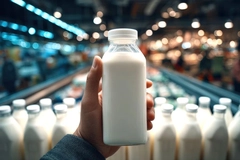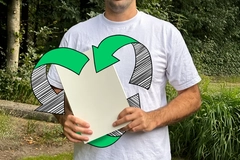US study reveals high levels of nanoplastics in bottled water, prompting health concerns

11 Jan 2024 --- Researchers have discovered nanoplastics in bottled water, shedding light on new concerns for water packaging. The study, employing stimulated Raman scattering microscopy, breaks down the composition of these minuscule particles, raising questions about the potential impact on human health and ecosystems.
Published in the Proceedings of the National Academy of Sciences, the study, conducted on three popular bottled water brands in the US, revealed an average of 240,000 detectable nanoplastic fragments per liter. This count is ten to a hundred times higher than previous estimates that primarily considered larger plastic particles.
Nanoplastics, measuring below 1 micrometer, are so tiny that they can traverse through the human digestive and respiratory systems, entering the bloodstream and potentially reaching vital organs, including the heart and brain. Another recent study further suggests that nanoplastics pose a risk by crossing the placenta and impacting unborn babies.
Dr. Beizhan Yan, an environmental chemist at Columbia University’s Lamont-Doherty Earth Observatory who co-authored the research, tells Packaging Insights: “Scientists are still in the early stages of studying these specific risks associated with the accumulation of these particles. However, evidence of the cytotoxicity and harmful effects of nanosized particles, black carbon and PM2.5 suggests the potential toxicity of nanoplastics.”
Yan says that formerly, the realm of nanoplastics largely remained obscure and unexplored. Assessments of toxicity were mere conjectures about its contents. He believes the new study can offer an opportunity to peer into some previously unrevealed issues.
Identifying and understanding nanoparticles
The research team identified seven common plastics in bottled waters, including PET, polyamide, polystyrene, polyvinyl chloride and polymethyl methacrylate.
PET, commonly used in bottled sodas, sports drinks and products such as ketchup and mayonnaise, was overshadowed by polyamide, a type of nylon. The latter likely originates from plastic filters used in water purification processes before bottling.
 Tiny bits of polystyrene plastic are detected by lasers (image credit: Naixin Qian, Columbia University).Dr. Wei Min, a co-author of the study and a Columbia biophysicist, emphasizes the importance of not only detecting but also understanding the nature of the particles found. The team’s algorithmic interpretation revealed the abundance and variety of nanoplastics, providing information for future biomedical research.
Tiny bits of polystyrene plastic are detected by lasers (image credit: Naixin Qian, Columbia University).Dr. Wei Min, a co-author of the study and a Columbia biophysicist, emphasizes the importance of not only detecting but also understanding the nature of the particles found. The team’s algorithmic interpretation revealed the abundance and variety of nanoplastics, providing information for future biomedical research.
The study also highlights that the seven plastic types found account for only 10% of the nanoparticles found, leaving the composition of the remaining 90% unknown.
Naixin Qian, the lead author of the study and a chemistry graduate student at Columbia University, says that the composition of the nanoparticles remained unknown. She highlights that earlier studies could offer overall estimates of nano mass but were generally unable to enumerate individual particles or distinguish whether they were plastics or other substances.
Qian also explains that discovering such a substantial amount of this material is not entirely surprising because the concept is that as things get smaller, their abundance increases.
Tracing the trail
Microplastics have previously been found in the water bottles of 11 major global brands, including Dasani, Epura, Aqua, Nestlé Pure Life and San Pellegrino. Exclusive testing conducted on over 250 bottles from nine countries found that 93% contained plastic debris, including polypropylene, nylon and polyethylene terephthalate.
The research team is currently planning to look into tap water, which also has been shown to contain microplastics, though far less than bottled water.
“Tracing the origins of these particles requires complete collaboration with the industry. The nanoplastics can be traced by measuring them in the source water, in water samples after each step and finally in the water bottle,” explains Yan.
Dr. Yan is currently leading a project examining the presence of microplastics and nanoplastics in wastewater generated during laundry processes. According to his ongoing research, millions of these particles are released per 10 pound load, originating from synthetic materials found in a variety of everyday items.
By Sichong Wang











